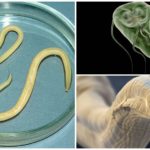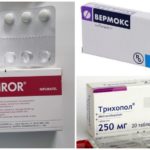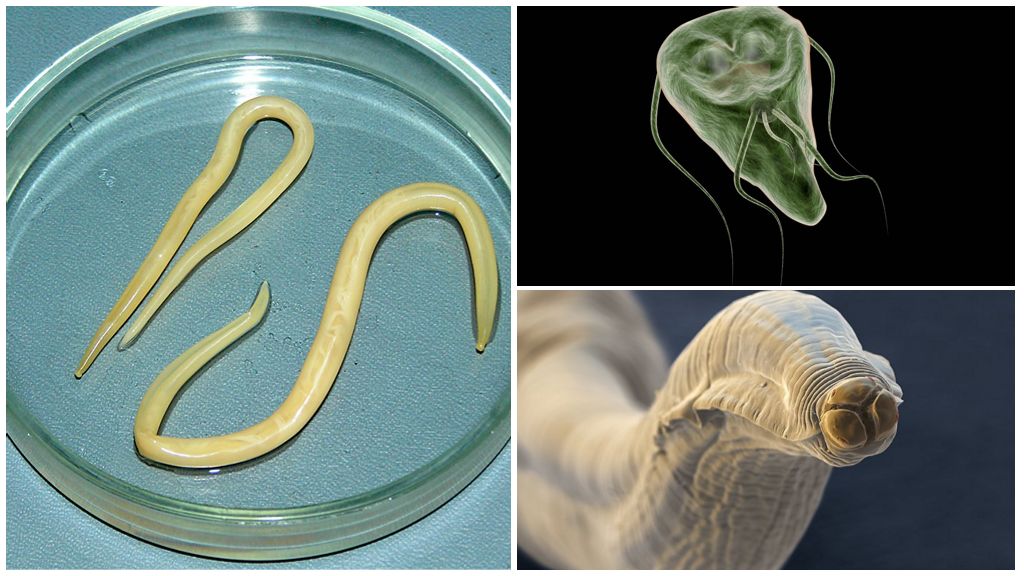Comparison of Giardia and Worms
Content
- Parasites
- Symptoms of helminthic invasion
- Preparations for the fight against parasites
Worms and Giardia are parasites that feed and multiply in the human body, causing severe damage to organs and systems. Many people mistakenly consider them representatives of one group and are called the common word helminths, which is fundamentally wrong. These microorganisms do have a number of similarities in the life cycle, but the harm to their health is disproportionately different.
External differences
If you look at the photo of worms and Giardia in a larger size, the difference between them is obvious. The main external difference is the size. Lamblia can reach a maximum length of 0.02 mm and it is impossible to see it without a microscope. Worms (helminths) grow to 30 meters (bovine tapeworm), and the smallest individuals are at least 5 mm (trichinella).
Lyamblia is the simplest organism of the family of flagellates. It has a pear-shaped body, several “legs” and a suction cup to attach to the intestinal wall. In appearance, the vegetative form of the parasite is similar to a harmless ciliate and does not cause disgust.
Worms, by contrast, have a repulsive appearance. All worms are worms of different structure, length and thickness. In nature, there are more than 400 types of these parasites. In form and structure, they are grouped into three groups: flukes, roundworms and tapeworms. The most common representatives have the following maximum dimensions in length:
- pork tapeworm from 3 to 5 meters;
- Ascaris to 50 cm;
- pinworm 1 cm;
- whipworm 5 cm;
- toksokara 18 cm;
- wide tapeworm 15 meters.
On a note!
The harm that parasites inflict on the human body is directly proportional to their size. From this we can conclude that Giardia is the most innocuous creature.
What are the similarities
Worms and Giardia have identical reproduction patterns and infection paths. Both types of parasites continue the life cycle as a result of repeated ingress into the host's oral cavity. Worms lay eggs for this purpose, many of their individuals crawl out of the rectum to the outside during this period.
Giardia in order to continue the race adapted to cyst formation. They are closed in durable capsules and go to the external environment. After cysts get into a person’s mouth, the life cycle gets continued.
Ways of transmission of worms and Giardia are also the same. You can become infected as a result of:
- drinking infected water;
- contact with animals that carry cysts, larvae and eggs;
- eating unwashed vegetables and fruits;
- poor hand hygiene.
Worm infection also occurs when meat and fish with larvae are eaten. Often, agricultural workers who are in close contact with animals are affected.
On a note!
Children are infected with worms and Giardia when playing on the street and in the presence of a source of infection in an educational institution. Young children are sick because of violations of the rules of hygiene parents.
Typical symptoms of giardiasis
Giardia mainly found in children under 7 years of age. The disease may be asymptomatic or in the form of intestinal disorders. General parasites inflict general harm to health only in the absence of treatment and in case of mass invasions. If Giardia is too much in the intestines, they begin to penetrate the hepatic ducts and the gallbladder. Symptoms of giardiasis appear:
- decreased appetite;
- dizziness;
- irritability;
- sleep disturbance;
- diarrhea or constipation;
- pain in the umbilical region;
- allergies.
When parasites hit the liver, signs of a hepatobiliary lesion join. The sclera of the eyes turn yellow, pain appears in the right hypochondrium and intoxication develops.
On a note!
Regardless of the severity of giardiasis, the disease does not cause life-threatening complications and does not end in death, which is not the case with helminthiasis.
Clinical manifestations of helminthic invasions
When comparing the symptoms of worms and lamblia, you can notice a similarity in the clinical picture. But the degree of its manifestation in helminth infections is several times stronger. Patients in the first stages of infection complain of:
- weakness;
- fatigue;
- impaired stool;
- bloating;
- rumbling in the intestines;
- nervous irritability.
As the parasites multiply, signs of poisoning with the products of the vital activity of worms join. It causes headaches, swollen lymph nodes, sleep disturbances and drastic weight loss. At the same time, secondary immunodeficiency and avitaminosis develop.
Important!
Mass invasions of large types of worms can cause disruption of the heart, kidneys, lungs and central nervous system. In the absence of therapy, a decrease in the immune status and localization of worms in vital organs, the pathology can be fatal.
Diagnostic features
To reveal giardiasis, it is sometimes sufficient to pass a stool test for cysts. With a negative result, it must be repeated two more times. If the parasite is not detected, an enzyme-linked immunosorbent assay for the detection of antibodies to Giardia (ELISA) is prescribed. You can make a diagnosis by PCR diagnostics. During the study, DNA is detected protozoa.
Detect worms, despite their impressive size, without enzyme immunoassay, too, will not work.Before the appearance of ELISA, the diagnosis of helminths sometimes lasted several months. This is due to the peculiarities of parasitizing certain types of worms. As a result, patients often died from generalized seeding with parasites. Such complications developed when the echinococcosis capsule ruptured.
On a note!
Now you can check for a number of helminthic invasions by a single blood donation from a vein. The revealed titer helps the doctor not only to determine whether there is an invasion, but also allows you to establish the timing of infection.
Treatment
Therapy of helminths and lamblia is built on the basis of an identical scheme. Initially appointed enzyme, antiallergic and adsorbent means. Develop a diet with restriction of sweets, baking, spicy dishes, fried and smoked.
Then prescribed drugs for the destruction of parasites and choleretic funds. Later, restorative therapy is performed. Vitamins, minerals, probiotics and immunomodulators are prescribed. For the expulsion of Giardia and worms, there are many drugstores. Giardiasis is more often treated:
- Vermoxom;
- Trichopolum;
- McMiror;
- Tiberal;
- Metronidazole.
The course of treatment depends on the type of drug and ranges from 1 day to a week. The dosage is prescribed in accordance with the patient's age and the severity of the pathology.
Worm infestations cannot always be cured in one week. Many helminth infections require therapy for 14 or more days, and to cure trichinosis and echinococcosis, you need to take pills for at least a month. The main antiparasitic agents can be divided into groups depending on the type of individual.
| Variety of worms | Drugs for treatment |
|---|---|
| Tapeworms | Fenasal, Niclosamide, Albendazole, Praziquantel. |
| Flukes | Chloxyl. |
| Roundworms | Mebendazole, Piperazin, Vermox, Dekaris. |
Most anti-parasitic drugs are available on prescription. Independently take funds for helminthic invasions is prohibited.
Important!
With the massive infection of large types of worms, their simultaneous death can cause severe poisoning by decay products. Therefore, a severe invasion should be treated by a doctor who prepares the body for possible intoxication.
Prevention
To prevent infection with Giardia and worms, you must follow identical rules. Fully isolated from contact with the larvae and cysts will not work.But infection can be avoided by preventing the pathogen from entering the oral cavity.
To do this, you should regularly wash your hands before eating, shortly cut off your nails, do not eat vegetables from the garden, without first washing them. After contact with cats and dogs, hands should also be treated with soap and warm water. To prevent heavy helminth infections, one should fry meat well and cut it only in gloves.
Conclusion
As a result of a detailed study of the parasitism features of protozoa and worms, it is possible to draw an unambiguous conclusion that Giardia and helminths are not the same thing. Microorganisms cause various diseases, differ in the severity of invasions and are treated with unequal preparations. Combines these creatures, in fact, only harm to humans and a parasitic lifestyle.











